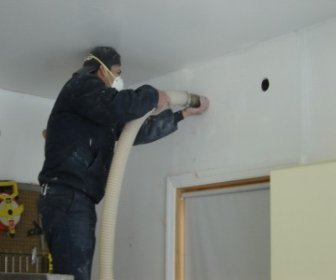Garage Insulating Basics
Garage insulating is something you can do yourself with little or no experience. It doesn't matter if your garage is attached or stands alone, if it's huge or small, or if it has an attic space or not. With a little bit of planning and a few basic tools, you can insulate your garage relatively fast. This page takes a look at some different garage insulation options and ideas.

Why Bother?
Two big reasons comfort and cost. Insulating will help your garage be warmer in the winter and cooler in the summer. You can also save on your energy bill if you insulate your garage.
Another benefit of garage insulation is noise reduction. Whether your garage is attached to your house or not, insulation will help reduce tool and/or project noise from disturbing your neighbors and family. A quality garage insulation job also makes a nice little selling point if and when that time comes.
First Things First
Every home garage is as different as its owner. There isn't a one-solution-fits-all for insulating home garages. Your local climate plays the biggest role in all of this. However, no matter where you are on the globe, you can take steps to better insulate your garage. That said, the following information on garage insulation is a general guideline from and for the average homeowner do-it-yourselfer. Make sure you choose a method of garage insulating that satisfies your local building codes. Also keep in mind that insulating is one of the last few stages in garage finishing , so make sure you've taken care of any electrical or plumbing needs prior to installing the insulation.
Getting Started
Know your garage. Some are attached to the home, some aren't. Some have adjacent living space, some don't. Some are dry-walled, and some aren't, some have attic space, and some don't. So before doing any garage insulating, create a simple plan that includes your garage insulation needs. The plan should include the size of the areas you'll be insulating as well as the types of insulation you'll be using.
The R-Value
Anytime you deal with garage insulating, you have to consider the R-Value. Simply put, the R-Value is how effective the insulation is. More specifically, the R-Value is a measurement of the insulating material's resistance to the movement of heat. In the garage, this translates to how much heat can move in from the outside, as well as out from the inside. Basically, the higher the R-Value, the more the insulation is going to resist the movement of heat in or out of your garage. Naturally, insulation with a higher R-Value also has a higher initial cost.
The idea, is if you install a higher R-Value insulation to begin with, then you'll see long term savings in heating (and/or) cooling costs. When it comes to garage insulating, it's a good idea to not go skimpy on the R-Value. For garage insulating, different products suit different applications. Most insulation packages have a printed table that tells you which R-Value is recommended for your specific application as well as your region and climate.
Types of Insulation
Let's take a look at the insulation itself. Generally, the different types of insulation are called forms. If you go to your local home improvement center, you'll see all kinds of forms, but there are basically four types: batts, loose-fill, reflective, and rigid. Batt insulation generally comes in rolls which are typically made from fiberglass and rock wool. The width of an insulation batt can vary, but the different sizes are designed to fit snugly between standard studs and joists. Batts can be used in unfinished walls, ceilings, attics, and floors.
Loose-fill insulation is much different than batt insulation. It's typically made from fiberglass, rock wool, and polyurethane foam. Instead of formed rolls, loose-fill insulation comes in small chunks that have to be blown or sprayed into the area they'll be insulating. With a hopper, loose-fill insulation can be sprayed into open wall cavities, or a dry-walled cavity that doesn't already have any insulation. This is nice because you don't have to tear down all the dry wall to get the job done. Loose-fill is also good, and very common in unfinished attic spaces.
Reflective insulation uses foil to reflect the heat which helps prevent it from moving in or out of the insulated space. Typically, the foil is attached to paper, cardboard, plastic, or polyethylene. Whichever type, it can be used like batt insulation between studs and joists, as well as ceilings, attics, and floors.
Finally, there's rigid insulation, which is typically made from polystyrene and polyurethane foam. The best feature of rigid insulation is its high r-value compared to its thin size. However, rigid insulation is also considered flammable so it has be covered with dry wall for fire safety. If it's used for an exterior application, then it has to be covered with some type of weather-proofing material as well.



